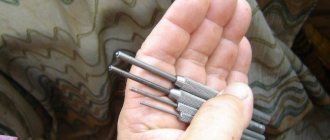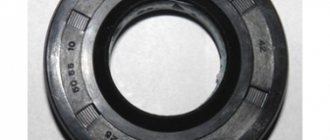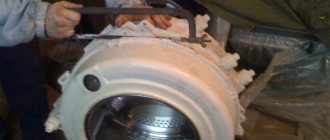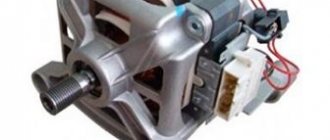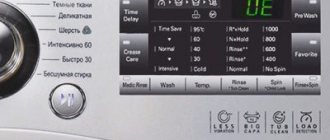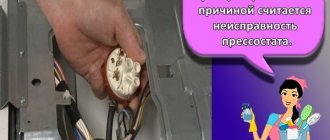Let's look at how to remove the shipping bolts on a washing machine. Transportation of large household appliances must be carried out in packaging using special fasteners. Any washing machine is equipped with shipping bolts that are necessary to secure the tank. They increase the service life of the device, prevent its damage due to impacts or careless handling when climbing to the floor, during transportation, loading and unloading.
If you do not use special fasteners, the drum may touch the inner walls and get defects. This is a dynamic part of the unit, which is easily susceptible to negative influences. In the absence of such devices, bearings with shock absorbers, as well as other components that ensure proper fastening of the tank and reduce its vibration during washing and spinning, may suffer. Transport components are necessary to securely fix the parts of the SMA and protect them from damage.
- How to remove shipping bolts?
- Mounting location
- Appearance
- We clean it ourselves
- Consequences of not removing transport bolts
- Recommendations for transporting the washing machine
- SMA catalog with reviews
How to remove shipping bolts?
An obligatory step in preparing the washing machine for operation is not only connecting to the electrical network, water supply and sewerage, but also timely removing the transport bolts. This must be done before the first wash. Operation of the device with them present is unacceptable. Forgotten parts may prevent the drain system from connecting correctly.
If the shipping bolts are not removed and a wash cycle is started, the device may break or be damaged. Warranty repairs in this case are not covered, so additional costs should be expected. Finding components and removing them yourself is quite simple, but if necessary, you can contact a specialist.
The fate of the guarantee
Even running a washing machine once with transport bolts will forever deprive the owner of the warranty provided to the machine. Washing with fasteners not removed is a direct violation of one of the main requirements of the instructions, which leads to automatic termination of the warranty period. Therefore, if the consumer wants to repair third-party breakdowns at the manufacturer’s expense, the consumer will receive a reasoned refusal from the service center.
It will not be possible to hide the fact of a violation of the warranty. If you do not remove the transportation bolts and start the machine, then characteristic damage will remain on the drum, which is easy to notice even with an unprofessional eye. Any further repairs will have to be paid for out-of-pocket.
Monetary losses are also expected when selling a washing machine.
Attention is paid to the condition of the drum first of all, and there is a high probability that after an unsuccessful start, an unpleasant knock and increased vibration will remain. Therefore, it is better to spend time and double-check again than to go to the store for a new machine
Manufacturers of large household appliances pay great attention to the safety of their products on the way to the end consumer. High-quality packaging almost completely protects the units from any external damage, provided, of course, that transportation rules are followed.
At the same time, due to the design features, the washing equipment contains devices that prevent damage to internal parts and mechanisms. Regardless of the type, each washing machine on the assembly line is equipped with transport bolts.
Mounting location
The location depends on the drum type and device model. Most front-loading units have mounting hardware on the rear panel of the chassis. Their number usually ranges from 2 to 5 pieces.
Transport bolt on the washing machine
Before loading for the first time, it is necessary to inspect the top and back of the machine. To find the fixing elements, just turn the back side towards you and carefully inspect it. Locations elsewhere are extremely rare. Some top-loading models may have parts located under the top cover.
On some modern washing devices, it can be difficult to find the bolts. In this case, instructions will come to the rescue. The exact position is usually indicated by the manufacturer in the user manual. There you can also find a detailed description of the procedure and dismantling features for this model.
Are you unplugging your washing machine?
Oh yes! No
Appearance
Shipping mounting screws are a simple design. It includes the following parts:
- hex bolt;
- washer;
- rubber ring;
- plastic insert.
A bolt is an oblong-shaped product with an external thread. It connects the moving parts of the unit. The plastic insert is designed to protect surfaces.
The rubber ring acts as a seal. The metal washer increases the support area and prevents loosening.
In rare cases, the manufacturer uses metal pins.
This is what the shipping bolts look like
We clean it ourselves
Dismantling does not require special professional skills. It is quite possible to cope with it yourself, having in your hands a minimum set of ordinary tools. There is no need to disassemble the case for this. The procedure will not take much time.
First, you should wait until the device warms up to room temperature after transportation. This is especially important if the action takes place during the cold season. Next, it is necessary to ensure free access to the rear panel of the unit. To do this, it should be moved away from the wall and turned around.
To remove the bolts without assistance, the following procedure is recommended:
- Take a wrench of a suitable size or an adjustable universal wrench, the size of which is adjustable. For some models, the tool is included in the kit.
- Loosen the screws by unscrewing them counterclockwise. They should not come out completely, but only 2-3 centimeters.
- Push the screw forward into the housing, pushing until it stops.
Do you wash your shoes in the machine?Oh yes! No
- Remove the plastic and rubber inserts, leaving the metal part out.
- Remove the fastening element.
- Place plastic plugs into the resulting holes, which are included in the kit along with other spare parts. They serve not only a decorative function. If you do not use plugs, moisture may enter the housing and the noise level during operation will increase. They should be pushed all the way until you hear a characteristic click.
- Place the removed parts in a plastic bag and save. They may come in handy in the future, for example when moving. If lost, you will have to buy new ones to ensure that the tank is firmly secured during transportation.
Expert opinion
I work in the household appliance repair industry. Extensive experience in restoring washing machines and dishwashers.
Ask a Question
If you don't have a wrench, you can use pliers or pliers. This is not the most convenient way, but it is quite effective.
It is suitable not only for bolts, but also for other types of pins. It is necessary to firmly grasp the part and turn it a quarter turn in any direction, after which the fasteners can be easily removed.
Design of fasteners
The body of the washing machine has pear-shaped holes with a small recess at the bottom. A bolt is placed in the hole, which is equipped with a plastic and steel washer. The plastic one is used on the side of the body so as not to scratch the surface. Steel is used as a tightening reinforcement, in which the clamp head will not destroy the plastic.
The fastener also has a plastic drum that fits over the bolt. This drum, together with the bolt, is inserted into the hole in the tank until it stops. Then the entire structure is lowered into the recess, thanks to which a secure fastening is achieved. Then the clamp is screwed into the nuts of the tank of the machine.
Consequences of not removing transport bolts
If you ignore the recommendations and do not free the case from unnecessary screws, the SMA will vibrate excessively and make noise during operation, or even break. In addition to knocking and humming, the following problems are possible:
- violation of integrity and premature wear of bearings;
- damage to shock absorbers;
- reducing the service life of the electric motor;
- failure of the heating element;
- malfunctions of parts and components located near the tank;
- Drive belt rupture.
Do you turn off the water tap after washing?
Oh yes! No.
Vibrations harm all elements of the washing machine. The dampers on which the drum is located act as shock absorbers. If there are bolts left, the vibrations will go directly to the body, which will make the washing process difficult and spinning simply impossible. This will lead to breakdowns and costly repairs of household appliances.
Recommendations for transporting the washing machine
To re-transport, you will have to perform the steps in reverse order:
- Remove the plugs with a knife or thin screwdriver and carefully pack.
- Insert the bolts into the resulting holes and screw them clockwise until they stop, using a rubber seal and a washer.
Expert opinion
I work in the household appliance repair industry. Extensive experience in restoring washing machines and dishwashers.
Ask a Question
If parts are lost during use of the equipment, then you should be careful when choosing new ones. Not all of them may be suitable.
In this case, to preserve the integrity of the internal components and parts, the washing machine is transported in compliance with the following recommendations:
- The case is laid horizontally or on its side, with the door down. Transportation in a vertical position is strictly prohibited. Since it entails various damage and imbalance of the tank. Moving with the door down is also undesirable. This can lead to moisture and detergent residues entering the electronic control module and causing it to fail.
- Wrap the drum with foam rubber or fabric; it is permissible to use pieces of foam plastic.
- To prevent damage to the electronics, it is necessary to thoroughly drain the water from the hoses and filter.
Fasteners are an important part of washing equipment. Their correct use extends their service life and reliably protects them during transportation. The main thing is not to forget to delete it before connecting.
Video
Possible problems and ways to solve them
When installing a new Bosch washing machine or one brought from another apartment, you can often encounter unforeseen situations and unexpected problems. In most cases, solving them is not difficult:
| Problem | Ways to solve the problem |
| Lost inlet hose | You can purchase a new hose of the required length on the Internet or in specialized stores. |
| The inlet or drain hose is not long enough | The supplied hose can be replaced with a part of the required length, or the communications can be brought closer to the installation site of the washing machine. |
| The sewer connection for the drain hose was not arranged in advance | As a temporary option, it is possible to use a washing machine with the drain hose with the free end thrown into the sink or bathtub |
| Despite the level setting, the washing machine moves during washing | If the flooring is made of glossy tiles, the legs of the washing machine may slide on it. The solution to the problem is to use a special mat for the washing machine or purchase pads on the legs that will prevent slipping. |
| Power surges often occur in the apartment | Output - connecting the washing machine through a voltage stabilizer |
| There is no cleaning agent available for the first use of the washing machine | You can use washing powder designed for automatic washing machines. |
| Uneven floor | Organize a reliable platform with a flat surface for the washing machine |
